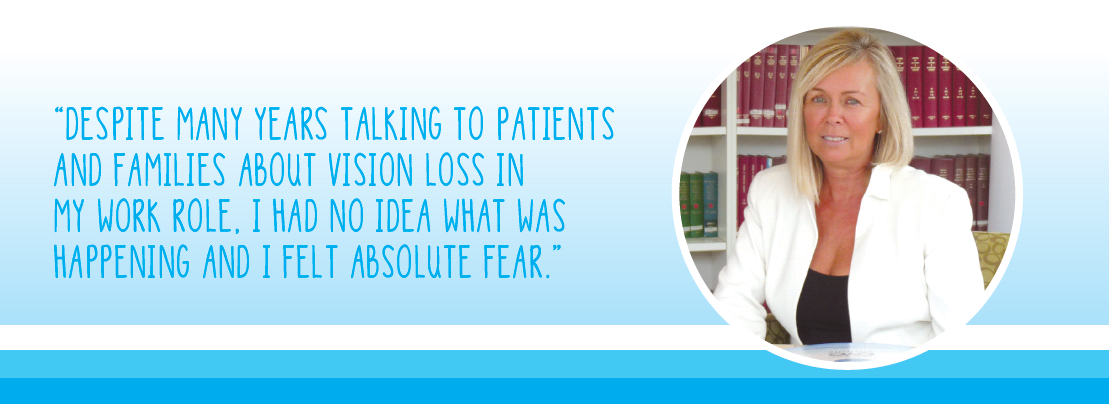It was October last year when the very first signs began to surface. Working at her computer it was hard to focus on the screen and her reading glasses didn’t seem to help. Thinking she was tired and may just need a break, she changed tasks and began other work that didn’t require the use of her computer.
For Jane Dodds, QEI Foundation’s Community Relations Manager, the changes to her vision were happening very quickly. Little did she realise, the worst was yet to come.
Visiting our donors and maintaining warm and lasting relationships, is something Jane relishes in her role at the Queensland Eye Institute. Very often this means driving to rural or more remote areas outside of Brisbane.
On the highway driving back from Warwick in mid October, Jane decided to pull over. Her view through the windscreen suddenly seemed strangely blurred and she was frustrated with her difficulty seeing the road in front of her. Jane used the wipers to clean her windscreen then sprayed her sunglasses with cleaner, thinking perhaps they were dirty or scratched. Neither made any difference.
Jane reached for her reading glasses and began to test her eyes, realising as she covered one eye that her sight on her right side had severely deteriorated. Blinking to try to focus, she discovered with horror that her vision appeared to improve only when she completely covered one eye. Something was terribly wrong. Sitting alone in her car by the side of the road, she thought back to the blurriness she had experienced in the week prior and felt enormous trepidation. Perhaps she had overlooked early warning signs that indicated something quite serious?

It was late afternoon but still light. There were few cars on the road and Jane rang her optometrist and then QEI’s clinic. The nurse at QEI was able to schedule an urgent appointment for her the following morning. Aware of her surrounds, she drove slowly home, remaining vigilant on the road but armed with a plan to stop again if her eyes worsened.
Early the following morning Jane was seen by one of Queensland Eye Institute’s optometrists and thorough tests were performed to investigate the cause of her blurred vision. To her optometrist it was clear Jane showed evidence of a condition called Pigment Dispersion Syndrome – a major cause of glaucoma. In addition to this, Jane was told she had an enormous cataract on her right eye and a smaller one on her left eye. Jane was referred to QEI Ophthalmologist, Dr Brendan Cronin for further review, who immediately confirmed her diagnosis.
Pigment Dispersion Syndrome is a major cause of glaucoma and can be potentially blinding. Although fairly rare, the condition can happen at any age. Dangerously, it is very often asymptomatic and can be slowly blinding without appropriate intervention.
The condition occurs when pigment cells come away from the back of the iris and float around the aqueous humour. Over time the ‘loose’ pigment cells can build up and clog the trabecular meshwork, causing problems with drainage in the eye and increasing pressure within the eye itself. Such increased pressure can then cause damage to the optic nerve resulting in what is known as Pigmentary Glaucoma. If damage had occurred to Jane’s optic nerve fibres, the vision loss would have been painless but irreversible.
Because the large cataract was on the back of the lens and was a rapid growing type, Jane required surgery quickly so that she could resume driving. Tests were repeated as she waited for her surgery date, only weeks away. The size of her cataract continued to increase dramatically. With no family history of such a condition, everything was becoming fuzzy, she felt nauseous and off balance.

Jane truly understood first hand what it meant to be a patient facing such awful fears. In two separate operations, she was soon admitted to South Bank Day Hospital. Dr Cronin operated on both of her eyes, completely replacing the lens in each.
Fortunately, Jane’s Pigment Dispersion Syndrome was diagnosed early. No scarring had occurred and it is unlikely she will develop glaucoma. After regular eye drops for a month, Jane still requires ongoing computerised visual field testing and ocular coherence tomography of her optic nerve at QEI’s outpatient clinic. Thankfully her vision has been restored.

The work we do at the Queensland Eye Institute changes the lives of people just like ‘our’ Jane every day.
Every year, whether we are training a new generation of doctors, conducting research to reduce the impact of eye diseases, or providing vital clinical care to preserve or restore sight, we are constantly making a difference to the lives of thousands of people in Queensland and across Australia.
Early diagnosis, as well as ways to prevent damaging eye conditions, can improve a person’s quality of life by preventing blindness or restoring sight.
But none of this is possible without your support.
As we enter the new year, you never know when you or someone close to you may need our help.